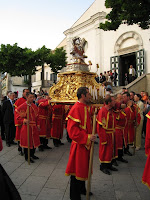18 May 2008
Mia Reinoso Genoni
miagenoni@post.harvard.edu
miagenoni@post.harvard.edu
We had something of a lazy Sunday on the Amalfi coast, relatively speaking. In the town of Amalfi itself we focused on the beautiful medieval cathedral, and also spent time just enjoying the area.
Amalfi Cathedral dates to the 10th through 12th centuries. It is a double cathedral complex, incorporating the earlier Church of the Crucifix as well as the main cathedral of San Andrea. In 1206 Amalfi acquired relics of St. Andrew, probably due to the 1204 Sack of Constantinople, and from this point onward was very invested in the apostolicity of the site. The facade pictured here was rebuilt in the late 19th century.
Like so many Campanian churches, San Andrea underwent a series of renovations throughout the centuries.
 The Church of the Crucifix primarily functions as museum now, and from it you enter the Crypt of St. Andrew:
The Church of the Crucifix primarily functions as museum now, and from it you enter the Crypt of St. Andrew:an elaborate space of apostolic celebration.
Of primary interest in the Amalfi Cathedral complex are the campanile and, especially, the Cloister of Paradise. In this view of the campanile framed by the arches of the Cloister, we see a melange of styles similar to that of the Salerno Cathedral.
 The upper register of the campanile is particularly playful and successful.
The upper register of the campanile is particularly playful and successful. The stepped arches and moldings of the Cloister are clearly influenced by the strong Islamic presence in this area; in addition, these structures are easy to mass produce and are light, making them an ideal solution for building upon a mountain.
The stepped arches and moldings of the Cloister are clearly influenced by the strong Islamic presence in this area; in addition, these structures are easy to mass produce and are light, making them an ideal solution for building upon a mountain. Of greatest import in regards to the Cloister (1266-8) are its origin and function. Bishop Augustariccio requested its creation, in order to have a cemetery for illustrious citizens - hence the name "Cloister of Paradise." Caroline Bruzelius spoke of her recent research on the topic, conveying her belief that at this time cathedrals such as Amalfi were competing with the monastic orders for the burial of the noble and wealthy. In this way the Cloister must be considered along with the Camposanto in Pisa, for example. For those not lucky enough to be on this trip, you can read about these ideas in greater detail in her new essay "The Dead Come to Town: Preaching, Burying, and Building in the Mendicant Orders," just published in The Year 1300 and the Creation of a New European Architecture, and/or await Bodies, Building, and the Medieval City, currently in progress.
Of greatest import in regards to the Cloister (1266-8) are its origin and function. Bishop Augustariccio requested its creation, in order to have a cemetery for illustrious citizens - hence the name "Cloister of Paradise." Caroline Bruzelius spoke of her recent research on the topic, conveying her belief that at this time cathedrals such as Amalfi were competing with the monastic orders for the burial of the noble and wealthy. In this way the Cloister must be considered along with the Camposanto in Pisa, for example. For those not lucky enough to be on this trip, you can read about these ideas in greater detail in her new essay "The Dead Come to Town: Preaching, Burying, and Building in the Mendicant Orders," just published in The Year 1300 and the Creation of a New European Architecture, and/or await Bodies, Building, and the Medieval City, currently in progress.Continuing up the mountain, we came to the town of Ravello, perched atop a cliff. Here we were treated to the magnificent Villa Rufolo (1260), belonging to a family of great wealth that was described by Boccaccio, a family that first profited from and then were persecuted by the Angevins.
 In the original phase of profit, the Villa, with its exquisite and extensive gardens, was built as a pleasure palace to delight the senses.
In the original phase of profit, the Villa, with its exquisite and extensive gardens, was built as a pleasure palace to delight the senses. Also in Ravello is the Cathedral of Santa Maria Assunta, founded by the first bishop of the city, Orso Papirio, in c. 1086-7.
Also in Ravello is the Cathedral of Santa Maria Assunta, founded by the first bishop of the city, Orso Papirio, in c. 1086-7. One of the highlights here is the Byzantinizing ambo built by Constantino Rogadeo in 1130, featuring before and after pictures from the story of Jonah and the whale.
One of the highlights here is the Byzantinizing ambo built by Constantino Rogadeo in 1130, featuring before and after pictures from the story of Jonah and the whale.



The cathedral is also dedicated to a local saint, Pantaleone, and our visit happened to coincide with his feast day, here documented in photos by Virginia Jansen (above) and a short video by Peter Goltra (below):










